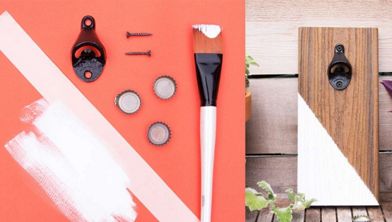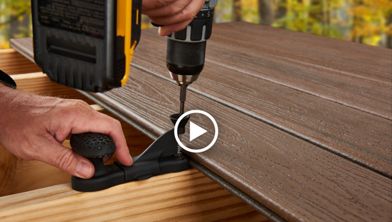For any home project, be certain to follow local code and permitting requirements.
Step 1: Install Pressure-Treated Posts
Posts should be installed at a maximum of 6’ or 8’ on center depending on the railing length being used.
Once you’ve confirmed the desired railing length, you’ll attach the posts using ½” carriage bolts with a minimum joist size of 2” x 8”. The top bolts must be 1” from tops of joists and bottom bolts must be 5-1/8” from top bolts.
Note: Blocking must be added for extra strength.
The attachment of the posts to the substructure is one of the most critical parts of a railing system. Ensure all local building codes are understood and followed. For further recommendations, please contact your local code official.
Step 2: Install Post Sleeve Skirts and Post Sleeves
Slide post sleeve skirts over the post all the way down to rest on the deck’s surface. Then slide the post sleeve over the post and position it inside the post sleeve skirt.
Note: Shims can be used to plumb post sleeves.
Pro Tip
For a simplified shopping experience, try the Trex Select® All-in-One Post Kit. Find a post cap, skirt, and sleeve with a new, modern design in one box.
Step 3: Cut Railings
Before cutting your railings, position both the bottom and top rails between posts to ensure baluster holes are lined up and spaced evenly.
Make sure to allow for a minimum of 1-9/16” on each end of rail from the edge of the baluster hole to the end of the rail for bracket placement. Mark cut locations on rails at the intersection of rails and posts.
Step 4: Attach Footblock to Bottom Rail
Before attaching the footblock, invert the bottom rail. Next, center and drill a hole using a 3/16” drill bit. This will be the location for the footblock attachment, which will be installed last.
Step 5: Attach Brackets to Rails
Position brackets on each side of the top rail and on the same side as baluster holes. Then, use the three provided #8-18 x 1” self-drilling screws to attach.
Do the same process on the bottom rail by positioning the brackets on each end of the bottom rail, but this time on the opposite side of the baluster holes. Again, attach using the three provided #8-18 x 1” self-drilling screws.
Step 6: Assemble Railing Station
Using a clean, flat surface, lay the bottom railing on its side. Next, place a scrap piece of 1” decking board to run parallel to the bottom rail for support when installing the balusters.
Insert the balusters into the bottom rail slots until they are fully seated.
Step 7: Attach Rail to Balusters
With the top rail, starting on one end and working toward the other, feed each baluster into its necessary slot.
Place a ratchet strap around the top and bottom rail and tighten until snug. This will help temporarily secure the railing section together.
Note: Do not overtighten strap as you may risk bending or breaking the railing.
Step 8: Install Railing Section to Posts
Gather scrap material (2 x 4s, decking boards, etc.) and cut at least three support blocks at 3-3/4” in height. Then, place one each on the decking surface beside each post and one near the center of span.
Lift the secured railing section up and center this section in between the spanned posts on pre-positioned support blocks.
Pro Tip
To help with railing stabilization, consider using a clamp to hold the first baluster to the post sleeve.
Step 9: Install Brackets
Now it’s time to install both bottom and top brackets on each side to the post using the two provided #8-10 x 2” wood screws.
Pro Tip
For best results, set your drill to the lowest speed when installing screws to avoid stripping or damaging your railing.
Step 10: Attach Post Caps and Install Footblock
To attach, secure the post caps with silicone or PVC adhesive. When it comes to attaching the footblocks, refer to the footblock instructions.
Tip: Be sure to clean up any excess adhesive before it dries.
Pro Tip
Be sure to clean up any excess adhesive before it dries.
For a more detailed set of installation tools, materials and instructions, download our full Installation Guide.
This content was partially or fully generated by AI and has been reviewed by our team to ensure accuracy and relevance.





































